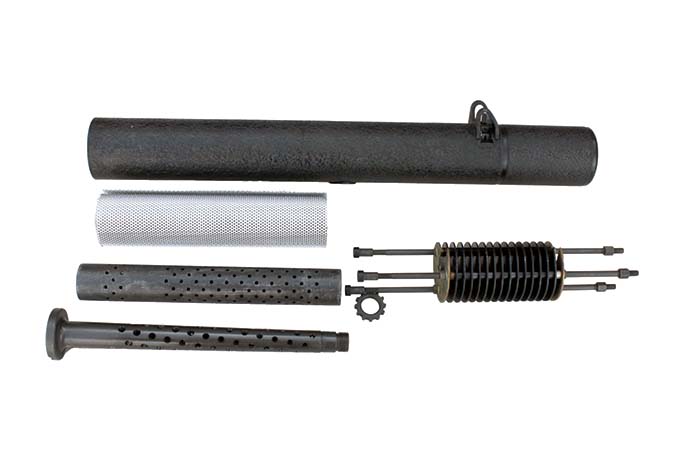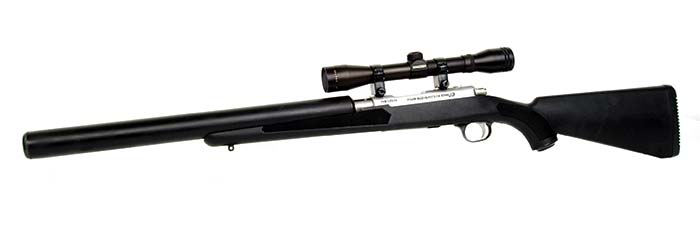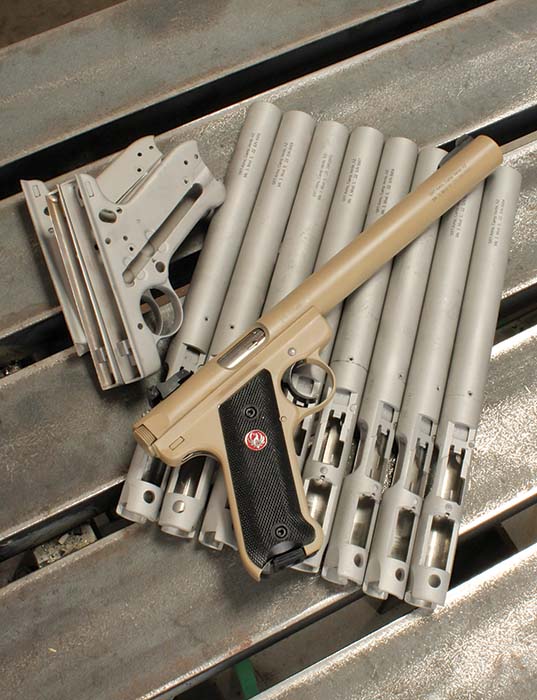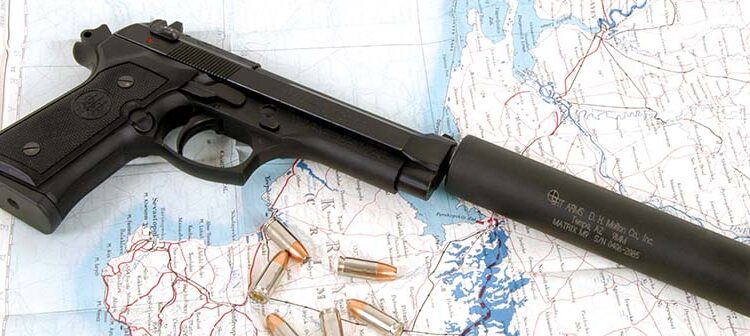By Art Merrill
First things first: it’s not a “silencer;” it’s a “suppressor.” Today, purists mentally shudder when someone calls a suppressor a “silencer,” much as knowledgeable shooters do when a neophyte calls a cartridge a “bullet” or a pistol magazine a “clip.” But did you know that history does not favor the suppressor purists? Even the legal definitions include “Silencer.”
In the late 1800s, W.W. Greener patented Greener’s Humane Cattle Killer, essentially a bell-shaped muzzle design that, when placed directly against the animal’s skull, deadened the sound of the shot. Greener experimented further with suppressing gunshot reports by means of a “long tube screwed to the end of the barrel, divided into chambers by cone-shaped walls,” he wrote in The Gun and Its Development, but quit without patenting it, citing difficulties with powder fouling and lack of a market.
Hiram Percy Maxim, son of the inventor of the Maxim machine gun, generally gets the credit for making and successfully marketing the first practical suppressor which, in his 1910 advertising, he called the “Maxim Silencer.”
“Silencer,” then, is a marketing word, a bit of hype predating truth-in-advertising laws, and, of course, an exaggeration of its performance.

Ssshhh
Suppressors work essentially the same way as the muffler on your car, slowing the velocity of expanding gases in a series of hollow expansion chambers. Reducing the gas velocity reduces the “bang” of the gas, but the bullet still emits a “crack” unless baffling the gas inside the suppressor also works to slow the bullet to below supersonic velocity. Various internal designs include cones, wipes, dead air spaces and sometimes a liquid, such as water or oil. Plastics will work for a limited number of shots in .22 rimfire.
WWII commandos and OSS operatives used suppressors. But, as Greener noted 50 years earlier, fouling reduced their effectiveness and so suppressors had a limited life (that’s still true today for sealed suppressors), and during the Cold War the U.S. Navy had a “throwaway” suppressor good for only about a half-dozen shots. In the 1950s, the suppressor for the British Sterling submachine gun was easily disassembled for cleaning, appealing to British government frugality. But the design just didn’t work well as designed. Gases that were supposed to be deflected and slowed by a corkscrew baffle simply blew past it and had to be handled by an aluminum wrap surrounding it. “And look at all those barrel ports,” said Doug Melton, suppressor designer and owner of SRT Arms, who provided the Sterling suppressor for examination. “That many ports is pretty much self-defeating.”
The barrel port design, in fact, is absolutely key to making an integral suppressor work well – so much so that Doug declined to allow any photos showing his own patented port designs.

SRT Arms in Camp Verde, Arizona manufactures top quality suppressors of stainless steel or titanium; both the familiar “can” style that screw onto the end of a barrel, and “integral” suppressors that essentially surround the entire length of a barrel.
“There are two ways to make a suppressor,” Doug said. “You can copy someone else’s or you can invest in R&D.” A professional mechanical engineer interested in suppressors since his teens, Doug went for R&D and began making his own designs in 1998.
Understanding what’s happening with supersonic, heated gases inside a suppressor is the stuff of NASA, but most private researchers don’t have the benefit of wind tunnels so R&D consists of years of trial-and-error, which can reap added benefits.
In addition to reducing noise, suppressors can reduce recoil and muzzle flash, and increase accuracy (by dampening barrel harmonics). In some SRT Arms suppressors, Doug has eliminated the phenomenon called “first round pop” (FRP), the first shot fired being louder than subsequent shots. FRP is caused by a combination of unburned powder and the ambient oxygen inside a suppressor, Doug said, which results in a pressure spike higher than that of succeeding shots.
SRT Arms titanium suppressors for sniping eliminate the cold bore shot familiar to precision shooters. And SRT Arms suppressors always deflect the bullet point of impact (POI) downward, rather than in a random direction.
“Other guys make suppressors with an ‘adjustable clocking feature’ where you have to fire a bunch of ammo to determine where the POI is, and then adjust the suppressor to where you want it,” Doug said.
SRT Arms makes “can” type suppressors for the kinds of guns you’d expect – ARs, bolt rifles and a variety of semiauto pistols. More unusual is the integral suppressor Doug builds onto a Ruger 77/44 .44 Magnum bolt action rifle. He can also integrally suppress just about any .22 rimfire rifle that doesn’t have a magazine tube under the barrel.
If SRT Arms has a flagship product, it’s probably the humble .22 rimfire Ruger MkIII pistol with integral suppressor. The 7.8” suppressor has the appearance of a target bull barrel, but the pistol is for very serious work.
“The Department of Defense wanted to shoot 40 grain CCI Mini-Mags, so the whole gun is adapted to that ammo,” Doug said, though it will work reliably with most 36-40gr high velocity ammo. As testament to its quality, Doug said the men to whom these guns are issued asked him to build 15 more for their personal use.
Want one? Doug will build it on the stainless Ruger KMK 512 MkIII that you provide. The suppressor can be disassembled for cleaning and will “last forever,” Doug said, if you clean it every 500 rounds. After 10,000 to 20,000 rounds, return it to SRT Arms for servicing.

Rating Suppressor Effectiveness
Do you still need hearing protection when using a suppressor? Even those unfamiliar with the physics of sound know that the measure of noise, the decibel (dB), is measured with a decibel meter. The OSHA dB limit for a single loud sound lasting less than one second, such as a gunshot, is 140dB. Claims that suppressors eliminate the need for hearing protection are often based on this OSHA standard. Subjective reality is a bit different. The quality of the suppressor – and its testing – will determine whether your protection-less shooting session leaves you hearing crickets in your head on the way home.
There were no qualms about foregoing hearing protection while shooting Doug’s suppressed .22 rimfires. The .44 Magnum subsonic load gunshots seemed hardly loud as a hand clap. I even braved staying protection-less with the suppressed .308 with standard loads, which also were neither painful nor loud. But when Doug started screwing the can on an AR-30 in .338 Lapua Magnum, I reached for my sound attenuators. “You don’t need those,” Doug insisted. He was right. The SRT suppressor held even the mighty Lapua round below 140dB.
In some European countries, hunters and target shooters routinely use suppressors. Suppressors are regulated in the U.S. under the National Firearms Act of 1934, and to own one you’ll need a federal background investigation and pay a $200 transfer tax for each suppressor. A few states have allowed the use of suppressors while hunting, and thankfully, laws are changing every day to allow this in more states. The combination of government red tape and the $200 tax, plus no need for suppressors, has kept them in the realm of simple curiosities that, for most, don’t make the cost-and-hassle cutoff.
That’s changing. About half the states now allow hunters to use suppressors. Arizona, for example, legalized their use just a year or two ago. Couple that with the fact that many coyotes and destructive feral pigs like to hang out near civilization, and a whole new opportunity for varmint hunting and controlling pest animals has opened up.
Whereas the sound of a centerfire rifle shot can be heard and identified for two miles or more, a suppressor limits that distance to a matter of yards, and it disguises the gunshot so that a listener can only ask, “What was that?” And isn’t that really the point?

Tested dB Levels.
As you read these dB levels recorded, they are in accordance with DoD specs – at the muzzle, not at the shooter’s ear where readings are about 3dB lower. As a comparison, when firing the standard velocity 9mm in the AR platform, the firing pin falling on an empty chamber registered 106.5dB. The highest reading during suppressed 9mm firing was 120.1dB. The difference between the suppressed gunshot and the “click” was only 13.6dB. Readings are averages over multiple shots using SRT Arms suppressors.
Ruger MKIII .22 RF integral suppressor
117.3dB CCI Mini-Mag
113.2dB Remington Subsonic
Ruger 77/44 .44 Magnum integral suppressor
126.7dB subsonic 265gr FP loads from Engel Ballistic Research, Inc. Smithville, TX.
137dB standard velocity .44 Mag factory load.
AR-15 9mm can suppressor
116.8dB Speer 147gr Lawman
Custom Savage 110 .308 8” “Shadow” can suppressor
137.2dB Black Hills 175gr Moly
134dB, same gun and load with 9.3” “Shadow XL” suppressor
AR-30 .338 Lapua Magnum 10.5” stainless steel “Shadow” suppressor
137.5dB 250gr standard velocity factory load
136.8dB, same gun and load with titanium “Shadow” suppressor
| This article first appeared in Small Arms Review V18N5 (October 2014) |












